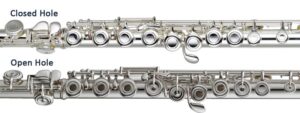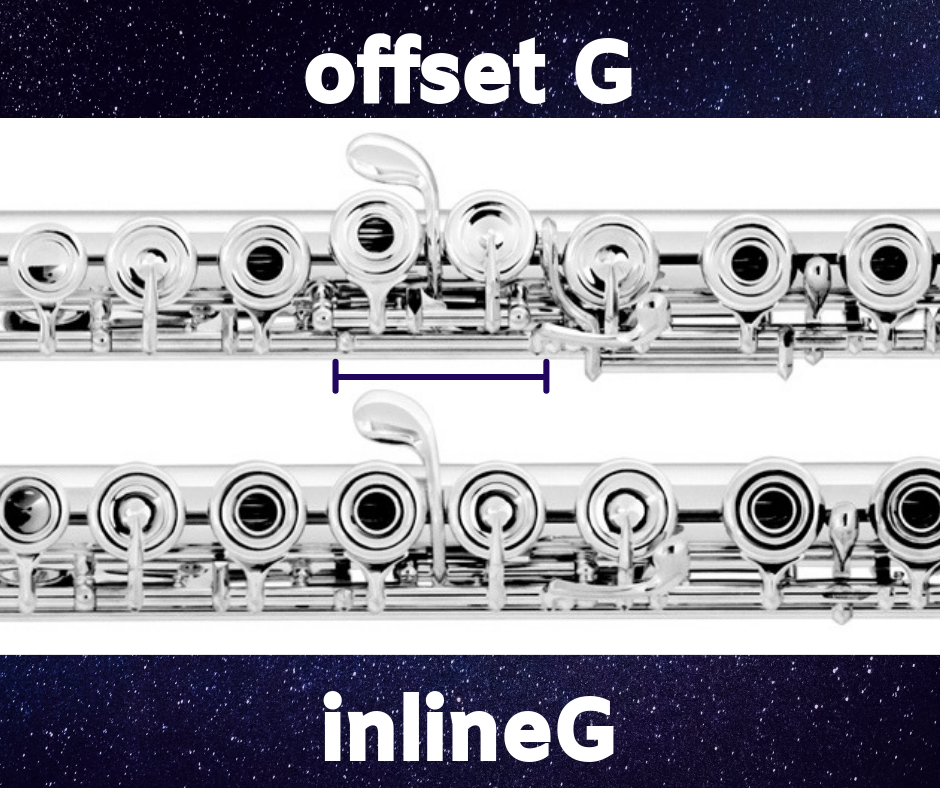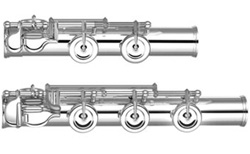What Features to Choose When Buying a Flute
Buying a flute can be a little daunting as there are many options on the market with various features to consider.
Read on further for options and features to help you choose.
Options and Features in Brief
They are:
1. Price
2. Closed hole flute versus open hole flute
3. Offset G versus inline G
4. Two features for third octave E sound
5. C foot joint versus B foot joint
6. C# trill key
7. Curved head joint
8. Size of Flute
9. Materials used in a flute
10. Brand
Options and Features in More Detail
1. Price
When you are buying a flute you may set price you are willing to pay. The good news is that new flutes range in price from around $50 to over $43,000 and so there are plenty to choose from to suit your budget.
There are different ranges of flute you can look at which are the beginner student flute, the intermediate flute and the professional flute. The differences in these are quality and nuances with more refined mechanism and sound as you go up the range. The difference in price is not always an indicator of quality.
So when starting out you want a flute you can afford, then you can upgrade to the intermediate flute then advanced professional flute as you gain experience.
2. Closed Hole Flute versus open Hole Flute

The Two Hole Types a Flute Has
Both types of flutes are good and is a preference as to which to go for when buying a flute.
Closed holed flutes have keys that are completely covered and are found on many beginner flutes. They are good for beginners because they are easier to play and are generally cheaper.
Open holed flutes have some have some keys with holes in the middle.
Intermediate and advanced players generally use open holes but some still opt for closed holes.
The advantage of an open hole flute is that you need to centre the finger tips on the holes to prevent leakage and this will help you create a nice natural hand position and more precise technique. There are also benefits of being able to bend notes and create different effects used in modern music.
An open holed flute comes with corks which you place in the holes to change it to closed holes. This is good to have whilst you are getting used to open hole playing.
3. Offset G versus Inline G
 This is where the two G keys and the G# lever are positioned.
This is where the two G keys and the G# lever are positioned.
In offset G flutes they are positioned slightly out from the rest of the keys and are mounted on different rods.
In inline G flutes they are positioned inline with the other keys and are mounted in the same rod.
There is no difference in the tone produced between the two flute types. It is all about which style is most comfortable for you. The fingering of the note G includes the G key and your forth finger in the left hand. The length of this forth finger and generally your overall hand size will help determine which style is best for you.
Offset G flutes are best suited for smaller hands and are seen on many beginner student flutes.
Inline G flutes are better suited for players with longer fingers or larger hands.
So test which is best for your hand size when buying a flute.
4. Two Features for Third Octave E Sound
There are two features on a flute that can help with the production of the third octave E. They are an option and so you have to decide if you need to have one of them or not. Read below for more details on the Split E Mechanism and the High E Facilitator.
Split E Mechanism
A split E mechanism on a flute is a little lever that is put on the side of the 2nd or lower G key and makes playing the 3rd octave E easier to play.
Normally when you finger the 3rd octave E without a split E mechanism, the two G keys stay up. With the split E mechanism the action of the two G keys are separated and the lower G key goes down. This makes the flute more responsive, helps with intonation and helps make the E easier to produce.
The split E is produced on the flute at manufacture and can be found on all levels of flutes. However it adds an extra cost to the flute.
High E Facilitator
This is a round, donut-shaped disc which you can add to the lower G key and partially covers the tone hole reducing the venting. It can also help with the tone of the third octave E and can be added at any time after purchase of flute. Therefore it is something you can consider if you don’t have a split E mechanism.
5. C Foot Joint versus B Foot Joint
The difference between these two foot joints is one key.

C Foot Joint
B Foot Joint
The C foot joint has two keys and the lowest note is C.
The B foot joint has three keys and the lowest note is B.
The B foot joint the flute is longer by about an inch and therefore is heavier and the balance may seem a little different to a flute with a C foot joint.
A B foot joint can also effect the tuning of the very top C. Therefore an extra key called a Gizmo key is placed next to the C and C# keys. When a player presses this down the B key goes down too and helps with the tuning of the high C.
So how often do you need to play low B? Not often.
If you are a beginner I would suggest a C foot joint. As you gain experience then it is a choice thing as to whether you go for a B or C foot joint.
People have noticed more depth of sound in the lower region with the B foot joint.
6. C # Trill Key
This is an extra trill key that can be fitted to enable easy playing of the trill B to C# and to help better intonation on some notes. It can be added to the flute at an extra cost.
7. Curved Headjoint
Typically the C flutes have a straight headjoint. Smaller beginners find this more difficult to play as the gap between mouthpiece and keys is too long for them. So there is another type of headjoint called the curved headjoint. This makes the distance between the mouthpiece and keys smaller and is great for young beginners eg 5, 6, 7 year olds.
8. Size of Flute
Flutes come in different sizes. Have a look below at the common ones
There is the
1. regular size C flute: People generally start playing on this size. You can use the standard headjoint or a curved headjoint.
2. piccolo: This is shorter than the regular and is in the key of C.
3. alto flute : This is larger than the regular C flute, is in the key of G and needs more breath from the player. You can use the standard headjoint or a curved headjoint.
4. bass flute: This is larger than the alto flute, is in the key of C and sounds one octave lower than the regular C flute. You can use a curved headjoint and get a support bar to help hold this flute up.
The regular flute and piccolo are played in many groups such as orchestras.
You can play any sized flutes in groups such as a flute choir.
9. Materials Used in a Flute
Flutes can be made in a variety of different materials including nickel, silver, gold and platinum. The most common material is silver.
Beginner flutes are typically made of nickel, silver or brass that is silver plated. More advanced flutes are made from solid silver, gold or platinum.
You can get a mixture of solid metal with plated metal. For example a solid silver headjoint with a silver plated body.
There are variations of sound depending on what materials are used.
The best idea is to try different variations of materials within your budget to determine which you like the best when buying a flute.
10. Brand
There are many brands ( view list of brands down left hand side ) of flutes which offer the range of beginner flutes to advance professional models with the variety of features as mentioned above.
It is best to try some flutes of different brands using the same desired features so you can make a direct comparison.
The flutes I have owned are:
1. Yamaha : This was my first flute. The features included silver plating, closed holes, C foot joint.
This is a popular current Yamaha flute to start your flute journey with.
2. Selmer : My second for most of my flute playing years. The features include solid silver headjoint with silver plated body, closed holes and C foot joint.
3. Haynes Q3: When I was buying a flute at the start of 2021 I was looking for features that I did not have in my Selmer flute. Hence I decided upon the Haynes Q3 flute. The features include Solid Stirling Silver throughout with 14k Gold Riser, open holes, B foot joint, split E , C# trill key.
Conclusion
There is a lot to consider when buying a flute.
If you are a beginner I would suggest a flute with closed holes, offset G, C footjoint and silver plated. A young beginner would benefit from a curved headjoint.
As you progress, other features like the split E mechanism for the high E sound and the C# trill key for the ease of playing several trills would be beneficial. However if you have the budget to begin and you think you will be playing the flute for a while with then you may like these features from the start.
The best thing to do is go to your local music store and have a look at the flutes and a chat to the staff. If you are not a beginner then play various brands and styles of flutes with the various features.
All the best in your search in buying a flute.
Don’t forget that if you would like lessons then please fill in an enrolment for here.
Happy Fluting